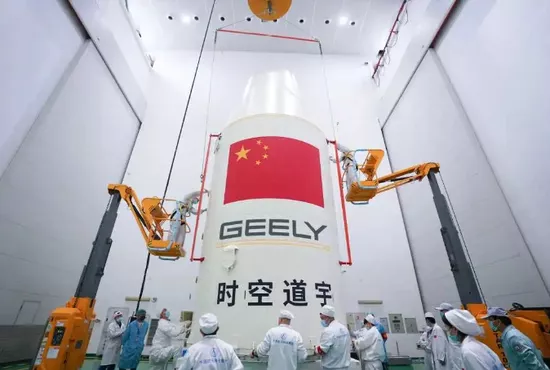A few days ago, the "Geely future travel constellation" successfully launched its first nine satellites in Xichang Satellite Launch Center in the form of one arrow and nine satellites, and the satellite successfully entered the scheduled orbit. The satellite was independently developed by Zhejiang spacetime Daoyu Technology Co., Ltd. under Geely technology group and produced by Taizhou satellite super factory. This means that Geely Holding Group has taken a key step in the development of commercial aerospace, thus becoming the first enterprise in China that "makes cars and stars with one hand".
From flying cars to chips, from mobile phones to low orbit satellites, Geely's cross-border has been questioned more than once as "not doing business". Even this "nine stars" feat, some people said they "can't understand". As an enterprise mainly engaged in making cars, the sudden release of satellites is indeed beyond people's imagination and makes people a little confused. However, if we take a longer view, we will find that these seemingly unrelated businesses are in fact the layout of enterprises for the future travel ecology.

At 12:00 on June 2, China successfully launched the Geely constellation 01 satellites by using the Long March 2C carrier rocket at the Xichang Satellite Launch Center. Nine satellites successfully entered the predetermined orbit, and the launch mission was a complete success. Photographed by lixiaomeng (issued by Xinhua News Agency)
With the vigorous development of a new round of scientific and technological revolution and industrial reform, the automobile is no longer just a mechanical product, but a mobile digital terminal. If we say that the first half of this change is electric, the second half is intelligent, and the ultimate goal is automatic driving. However, one of the bottlenecks of automatic driving at present is that the positioning accuracy is not enough. At present, the civil positioning accuracy of Beidou and GPS systems is between 5M and 10m, which cannot be used for lane discrimination. The space-time integrated high-precision space-time information system built by "Geely future travel constellation" can achieve positioning service accuracy of centimeter level. This is self-evident for the demand for high-precision positioning of autonomous driving and the significance of improving users' intelligent travel experience.
In fact, Li Shufu was not the first person to enter space. As early as 2002, Tesla CEO musk established SpaceX, a space exploration technology company. SpaceX not only built recoverable rockets, which greatly reduced the launch cost of commercial satellites, but also formed a data transmission and global communication network between air and ground through the establishment of a large-scale "star chain" system.

Data map
Different from the global communication system covered by Musk's "star chain", the ground-based ppp-rtk (precision single point positioning PPP and real-time dynamic positioning RTK are the most widely used and representative technologies in high-precision satellite navigation and positioning) space-time information network, as well as the Beidou 3 module and terminal products, which have been completed by Geely's first orbit nine satellites combined with space-time Daoyu, will realize the integrated application of remote sensing, navigation and communication technologies. The application scenario of this system is broader. It can not only support the Internet of vehicles, autonomous driving and flying cars to achieve low altitude accurate positioning, but also connect with mobile phones, smart wearable devices and other consumer electronics products, and embed unmanned systems and smart cities. In addition, it can provide all-round services in the fields of ocean, logistics, surveying and mapping, etc.
In general, Geely's layout has at least three implications: first, through the manufacturing and launching of LEO satellites, Geely has formed a strong synergy with Geely Automobile in terms of navigation and vehicle networking; Second, the frequency band and orbital position are non renewable resources, which are first come, first served. The "space infrastructure" will help Geely to further expand its future in fields other than remote sensing and the Internet of things; Third, in the face of industrial changes and the rise of new forces in car making, traditional car companies have accelerated the transformation to science and technology-based enterprises and entered the aerospace industry, which is conducive to Geely to enhance its brand sense of science and technology, thus promoting the brand upward. Of course, it is also possible to improve the valuation of enterprises in the capital market. With the successful launch of the "star chain plan" satellite, Tesla's market value has now reached more than 700billion US dollars. It is very illustrative that it has surpassed Toyota to become the world's No. 1 automobile company in terms of market value.
The large-scale integration of the aerospace industry and the automotive industry will bring about profound changes in the business application scenarios, and help to enhance the corporate brand image and sense of science and technology. However, both the low orbit satellite field and the automobile field are fields with high technical barriers, large investment and long-term accumulation. In the market with the most abundant automobile production and marketing and commercial application scenarios in the world, Geely should not be just an orphan among automobile enterprises to participate in the global competition of commercial aerospace.